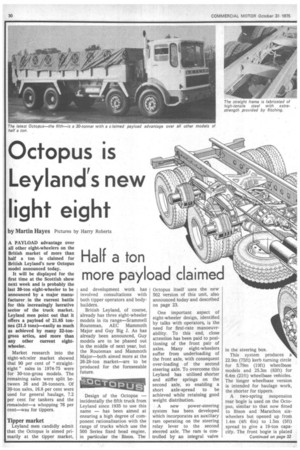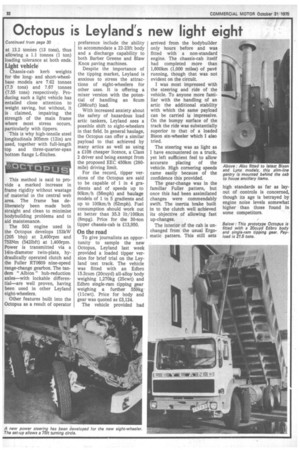Design of the Octopus — incidentally the fifth truck from
Page 32

Page 34

If you've noticed an error in this article please click here to report it so we can fix it.
Leyland since 1935 to use this name — has been aimed at ensuring a high degree of component rationalisation with the range of trucks which use the 500 Series fixed head engine, in particular the Bison. The Octopus itself uses the new 502 version of this unit, also announced today and described on page 23.
One important aspect of eight-wheeler design, identified by talks with operators, is the need for first-rate manoeuvrability. To this end, close attention has been paid to positioning of the front pair of axles. Many eight-wheelers suffer from underloading of the front axle, with consequent over-loading of the second steering axle. To overcome this Leyland has utilised shorter and stiffer springs on the second axle, so enabling a short axle-spread to be achieved while retaining good weight distribution.
A new power-steering system has been developed which incorporates an auxiliary ram operating on the steering relay lever to the second steered axle. The ram is controlled by an integral valve in the steering box.
This system produces a 22.9m (75ft) kerb turning circle for 5.79m (19ft) wheelbase models and 25.3m (83ft) for 6.4m (21ft) wheelbase vehicles. The longer wheelbase version is intended for haulage work, the shorter for tippers.
A two-spring suspension rear bogie is used on the Octopus, similar to that now fitted to Bison and Marathon sixwheelers but opened up from I.4m (4ft 6in) to 1.5m (5ft) spread to give a 19-ton capacity. The front bogie is plated at 13.2 tonnes (13 tons), thus allowing a 1.1 tonnes (1 ton) loading tolerance at both ends.
Light vehicle
Chassis-cab kerb weights for the longand short-wheelbase models are 7.62 tonnes (7.5 tons) and 7.67 tonnes (7.55 tons) respectively. Producing such a light vehicle has entailed close attention to weight saving, but without, it is claimed, impairing the strength of the main frame where most stress occurs, particularly with tippers.
This is why high-tensile steel longitudinals 305mm (12in) are used, together with full-length top and three-quarter-span bottom flange L-flitches.
































































































